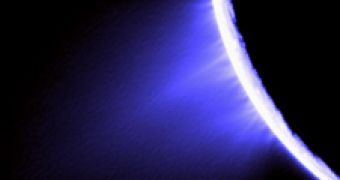It is a well known fact that Saturn's ring E is interacting with the moon Enceladus, and might have been created by drawing material ejected through cryo-volcanism phenomenons taking place of the surface of the moon. However, new observations conducted by NASA's Cassini orbiter reveal that icy plumes of material could also be delivered to the most distant ring in relation to Enceladus, ring A, situated 100,000 kilometers away from the small moon.
Dr William Farrell from NASA's Goddard Space Flight Center, the lead author of the study, says that prior to the observations made with Cassini, astrophysicists believed that ring A and Enceladus were separated and existed as two different entities. Material is ejected by ice geysers on Enceladus and captured by ring E. Then the magnetic field of the planet turns it into a plasma - which could also explain why Saturn has a donut-shaped cloud spinning around it - subsequently the plasma being redirected towards the ring A that absorbs it completely.
As particles rise above the surface of the moon, they are hit by sunlight and solar wind which ionizes them, making it relatively easy for Saturn's powerful magnetic field to capture them. Eventually, a part of the plasma trapped in the magnetic lines is being transported back and forth between the two poles of the planet, while the rest are carried to ring A.
This is only one of the processes responsible for the low levels of radiation around Saturn. Jupiter, which does not have dense rings of material around it, cannot dispose of the high-energy particles in the way Saturn does, thus the area around it is an extremely persistent highly radioactive environment.
The study conducted by Dr Farell confirms an earlier prediction made in the 1990 by Dr John Richardson, based on observations made with the Hubble Space Telescope, showing the presence of a large body of water-related molecules orbiting the planet about 240,000 kilometers away. Models made by Dr Richardson have proven that eventually the cloud would be transported towards the inner ring of the planet, where they would be absorbed. Nonetheless, at the time there was no clear source for the water cloud.
The Cassini probe only discovered the ice geysers on Enceladus in 2005. The first evidence that indeed the ring A was collecting material ejected from Enceladus came in 2004, the year when Cassini-Huygens reached Saturn, during a fly-by over the ring A. Radio emissions coming from the part of the plasma donut colliding with ring A indicated the plasma density in the inner regions of the donut. The higher the frequency of the radio emission, the higher the density of the plasma, which meant that Cassini's Radio and Plasma Wave instrument was able to monitor the density of the plasma donut in relation to the time.
The lower radio frequency near the ring A suggested that the plasma density in that area was smaller because it had been absorbed by the ring itself. Also, radio signal around the gaps in the rings were much higher in frequency, thus the plasma density is much higher because plasma is going right through the gaps instead of being absorbed.

 14 DAY TRIAL //
14 DAY TRIAL //